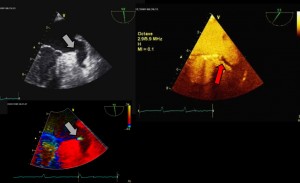This example shows a mobile structure at the entrance of the left atrial appendage. With tissue velocity imaging, there is an alaising in the area of the highly mobile thrombus. After the injection of a contrast agent, the mobile thrombus is not visible. Therefore, a broad-based filling defect can be recognized, a “laminated” thrombus. Unfortunately, the contrast enhanced images have not been documented in the same planes as the unenhanced images. The term “laminated” thrombus is taken from the publication: Cardiovascular Imaging in the Management of Atrial Fibrillation, J Am Coll Cardiol 2006;48:2077– 84.

